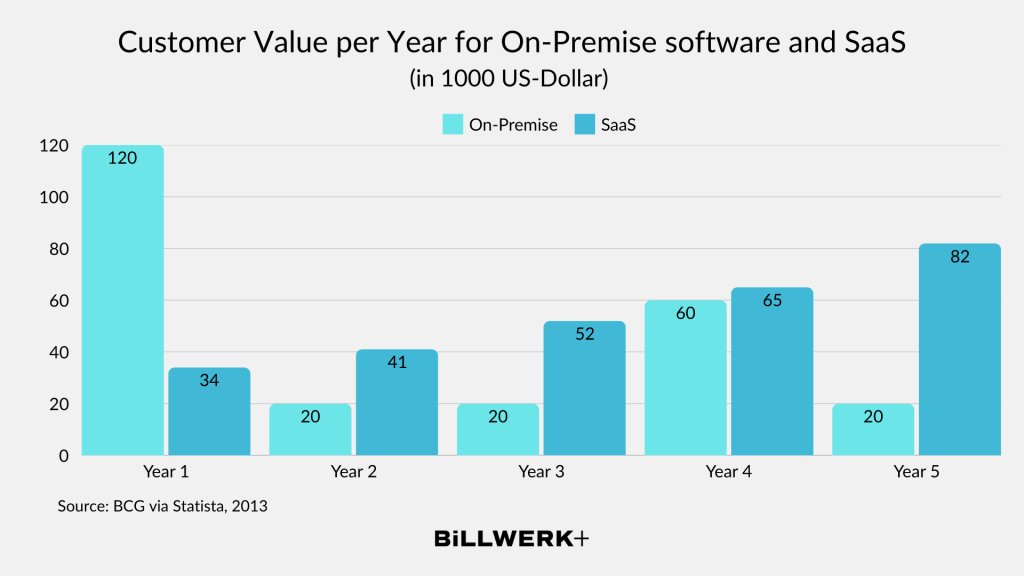High and Low: How to balance your subscription CLV and CAC
Published: February 20, 2025
CAC : CLV Ratio
It’s a simple and logical calculation: the budget you need to invest to gain a customer has to be exceeded by the revenue the customer makes.
A typical answer to the perfect ratio or balance is 1:3, so the costs you invest in the customer acquisition needs to result in 3 times the revenue to stay even.
However, this should be the bare minimum goal, since many CAC calculations tend to forget hidden costs (e.g., marketing and sales resources, time invest, etc.). 1:4 or even 1:5 should be the goal you set yourself, even though the latter is considered a bit of a lottery win.
An incredibly interesting survey by BCG (via Statista) showed that for SaaS companies, the true value lies in long customer relationships. As you can see, lifetime value of B2B on-premise software customers was the highest in its first year. In fact, the following 4 years combined earned as much revenue as the first year. However, the lifetime value for SaaS grows with each year, meaning that short-lived customer relationships keep overall profits down.
In short: customer lifetime value for SaaS is mostly defined by longevity.

The explanation is fairly simple:
- For on-premise software, it usually takes a lot of consultation workshops, trainings and other initial costs that the customer has to pay. It’s basically part of the on-premise software package to invest a lot at first, so you can be more independent later on.
- Once the system is in place, maintenance and other things are usually done by internal IT teams, so the revenue for the vendor is much lower.
- by the way, the increase during year 4 might be due to bigger “updates”, which for on-premise software still is a bit more complex than updates for cloud-applications which usually run in the background without much disruption.
However, for SaaS customers, the first year customer value is on average relatively low and will rise each year
(the data did not go further than five years)
For SaaS customers (and many other digital subscription customers), the initial acquisition vs. value ratio usually is less favorable in the first year due to typical subscription standards:
- Freemiums, free trials, discounts and other incentives decrease early revenue flows
- Sales and service teams usually offer their onboarding support for free, to reduce early churn rates.
- Once customers are properly onboarded and setup, however, there’s relatively few expenses but there’s more opportunities for up-sells or cross-sells (e.g., premium plans, more user accounts, etc.).
This means, that the customer lifetime value is highly dependent on a long customer life which also affects acquisition measures and customer expectations. Overselling a product or providing incentives for the wrong audience might decrease the CAC and purchase decision cycle but can also negatively effect the CLV and thus hurt the bottom line.
How to keep CAC low
- Target buyer personas & audiences based on your most profitable customers (a target that’s too broad can increase CAC and lower conversions while increasing early churn rates)
- Make use of incentives but be aware that some incentives might increase a high early churn (e.g., after a discount or free trial period is over)
- Be generous with making all information easily accessible that might play a part in the purchase decision (e.g., pricing, product details, compliance, software requirements, etc.).
- Depending on your industry: offer test trials at lower prices or freemiums (read here, when these can help your conversions).
- Enable referrals through partners, customers (e.g. with rewards), and influencer campaigns. People trust people.
- Work with relevant inbound marketing content that talks about your target audience’s problems, offers solutions and provides tipps how to use your products and services for an optimized experience.
How to keep CLV high
- Reduce involuntary churn (e.g. via automatic payment retries, credit card tokens, and more).
- Make use of predictive analytics to identify customers in risk of churn and act before they unsubscribe.
- Nurture and reward your existing customers (e.g. with loyalty programs, relevant discounts, anniversary celebrations, etc.).
- Enable seamless service experiences across all channels (self-service, customer portal, in-person, social media, etc.).
- Constantly monitor, identify and remove frictions in the customer journey via reviews, support issues, complaints and other customer data.
CLV & expansion revenue: the dream team
Expansion revenue is the term for any additional revenue that can be made with existing customers by up-selling or cross-selling. Expansion revenue is the golden key to long-term success, since it gains new revenue streams from existing customers.
According to studies (such as KeyBanc’s report from 2021, PDF), the CAC-ratio for newly generated ARR between new customers vs. existing customers differs widely:
(Sales and marketing budget needed to gain 1 US-Dollar of new ARR from a new customer)
New customer CAC ratio: 1,67 US-Dollars ARR
Existing customer CAC ratio: 0,63 US-Dollars ARR
So, existing customer CAC is not only 265% lower than the new customer CAC but the ARR is also much higher than the costs, which means it creates profit right out of the gate, whereas new customers usually need to generate revenue for a while to “pay back” the CAC.

Billwerk+ supports you with the right platform to setup, manage and optimize your subscription and membership journeys and optimize your CAC and CLV. Pick from a wide variety of incentives, experiment with your pricing and subscription models and make use of our numerous features to reduce churn and increase customer loyalty.



